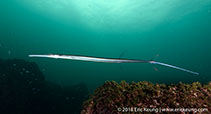| Family: |
Fistulariidae (Cornetfishes) |
| Max. size: |
160 cm TL (male/unsexed) |
| Environment: |
reef-associated; marine; depth range 0 - 132 m |
| Distribution: |
Indo-Pacific: East Africa and Red Sea and to Rapa and Easter Island, north to southern Japan, south to Australia and New Zealand (Ref. 5755). Eastern Central Pacific: Mexico to Panama, including offshore islands (Ref. 9301). Lessepsian migrant to the Mediterranean; first reported in Ref. 36327, and from several countries as of late year 2010. |
| Diagnosis: |
Dorsal spines (total): 0-0; Dorsal soft rays (total): 14-17; Anal spines: 0-0; Anal soft rays: 14-16; Vertebrae: 83-86. Vertically flattened rather than laterally compressed body. Long whiplike tail filament. Color is green dorsally, grading to silvery white ventrally, with two blue stripes or rows of blue spots on the back. Dorsal and anal fin orange becoming transparent at base. Caudal filament white. Broadly banded at night (Ref. 48635). First four vertebrae fused (Ref. 9826). Branchiostegal rays: 5 (Ref. 36710). |
| Biology: |
Adults inhabit reef habitats to a depth of at least 128 m, except in heavy surge areas. Also found in sandy bottoms adjacent to reef areas (Ref. 36710), either solitary or in schools (Ref. 9710). Benthopelagic (Ref. 58302). Feed on small fishes, shrimps (Ref. 36327, 36710) and squids (Ref. 37816). Probably marketed fresh, salted or dried or smoked but more often reduced to fish meal (Ref. 9301). |
| IUCN Red List Status: |
Least Concern (LC); Date assessed: 21 January 2016 Ref. (130435)
|
| Threat to humans: |
reports of ciguatera poisoning |
Source and more info: www.fishbase.org. For personal, classroom, and other internal use only. Not for publication.
